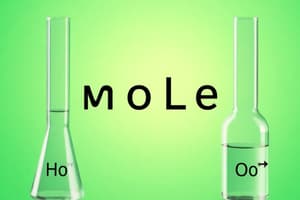Podcast
Questions and Answers
What does stoichiometry focus on?
What does stoichiometry focus on?
- Quantifying the speed of a reaction
- Measuring and relating the quantities of reactants and products in a chemical reaction (correct)
- Describing the physical properties of elements and compounds
- Predicting the color changes in chemical reactions
What does the term 'stoichiometry' mean?
What does the term 'stoichiometry' mean?
- Reaction prediction
- Element measure (correct)
- Particle quantity
- Bond formation
What is the mole in chemistry?
What is the mole in chemistry?
- The color change observed in reactions
- A unit representing a specific numerical value of a substance (correct)
- The speed at which a reaction occurs
- A measure of temperature in chemical reactions
How is the mole concept used in stoichiometry?
How is the mole concept used in stoichiometry?
What do balanced chemical equations represent?
What do balanced chemical equations represent?
In a chemical reaction, what do the reactants and products represent?
In a chemical reaction, what do the reactants and products represent?
What does the stoichiometric ratio of 2:1:1:1 for the balanced equation 2A + B → C + D indicate?
What does the stoichiometric ratio of 2:1:1:1 for the balanced equation 2A + B → C + D indicate?
In reaction stoichiometry, what does a 2:1 stoichiometry between hydrogen and oxygen mean?
In reaction stoichiometry, what does a 2:1 stoichiometry between hydrogen and oxygen mean?
What is the function of a limiting reactant in a chemical reaction?
What is the function of a limiting reactant in a chemical reaction?
If a reaction involves 3 moles of A and 2 moles of B with a stoichiometric ratio of 3:2, which reactant is the limiting reactant?
If a reaction involves 3 moles of A and 2 moles of B with a stoichiometric ratio of 3:2, which reactant is the limiting reactant?
How do stoichiometric calculations differ from reaction stoichiometry in chemistry?
How do stoichiometric calculations differ from reaction stoichiometry in chemistry?
Why is stoichiometry considered a crucial concept in chemistry?
Why is stoichiometry considered a crucial concept in chemistry?
Study Notes
Stoichiometry: Understanding Mole Concept, Chemical Reactions, and Stoichiometric Calculations
Introduction
Stoichiometry is a branch of chemistry that deals with the relationships between the reactants and products in a chemical reaction. It involves understanding the numerical relationships between the elements and compounds involved in a reaction, which are encoded in balanced chemical equations. The term "stoichiometry" is derived from the Ancient Greek words 'stoicheion' (element) and 'metron' (measure), reflecting its focus on measuring and relating the quantities of reactants and products.
Mole Concept
The mole is a fundamental unit in chemistry, representing a specific numerical value of a substance. It is defined as the amount of a substance that contains the same number of particles as there are atoms in 12 grams of carbon-12. The mole is used to relate the mass of a substance to the number of particles it contains. In stoichiometry, we use the mole concept to understand the relationships between reactants and products in chemical reactions.
Chemical Reactions
Chemical reactions are processes in which substances are transformed from one form into another. They involve the breaking and forming of chemical bonds between atoms. A balanced chemical equation represents a chemical reaction, showing the reactants (the substances that react) on the left and the products (the substances formed) on the right. The coefficients in front of each chemical symbol indicate the number of moles of each substance involved in the reaction.
Stoichiometric Calculations
Stoichiometric calculations involve using the relationships between reactants and products in a chemical reaction to determine the quantities of substances involved. These calculations are based on the law of conservation of mass, which states that the total mass of reactants must equal the total mass of products. For example, if the balanced equation for a reaction is 2A + B → C + D, the stoichiometric ratio is 2:1:1:1, meaning that for every 2 moles of A, 1 mole of B is required, and 1 mole of C and 1 mole of D are formed.
Reaction Stoichiometry
Reaction stoichiometry deals with the relationships between the moles of reactants and products in a chemical reaction. It is based on the principle that mass is conserved in a chemical reaction. For example, in the reaction between hydrogen and oxygen to form water, the stoichiometry is 2:1, meaning that for every 2 moles of hydrogen, 1 mole of oxygen is required, and 1 mole of water is formed.
Limiting Reactants
In a chemical reaction, the limiting reactant is the reactant that determines the amount of product that can be formed. It is the reactant that gets used up first, when the reaction is carried out under stoichiometric conditions. For example, if a reaction involves 2 moles of A and 1 mole of B, and the stoichiometry is 2:1, then the limiting reactant is A, and only 1 mole of B will be formed. The concept of limiting reactants is important in stoichiometry, as it determines the maximum amount of product that can be formed from a given amount of reactants.
In conclusion, stoichiometry is a crucial concept in chemistry, allowing us to understand the relationships between the reactants and products in a chemical reaction. By using the mole concept, understanding chemical reactions, and performing stoichiometric calculations, we can predict the yields of chemical reactions and understand the changes in mass and composition of substances undergoing chemical transformations.
Studying That Suits You
Use AI to generate personalized quizzes and flashcards to suit your learning preferences.
Description
Test your understanding of stoichiometry in chemistry with this quiz covering the mole concept, chemical reactions, stoichiometric calculations, reaction stoichiometry, and limiting reactants. Learn how to relate the quantities of substances in a reaction, use balanced chemical equations, and determine the maximum product yield.




